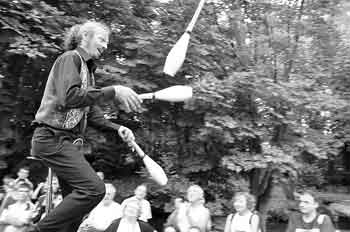Diachronic and Synchronic
Diachronic and Synchronic are two logics of order, meaning, and expression which oppose and/or complement one another.Diachronicthe sequential logic of a road
|
Synchronicthe all-at-once logic of a pool
|
 |
 |
| Process | Structure |
| "What Comes After What" | "What Goes With What" |
| Cause and Effect Order | Associative Order (non-sequential) |
| Meaning from Plot, Sequence | Meaning from Proximity, Contrast, Similarity, Hierarchy |
| Anticipation and Satisfaction | Connections and Patterns |
| Like a road you're traveling down | Like a pool of people and objects you climb into |
Individuals on a family tree are diachronically |
Individuals on a company's organizational chart are synchronically organized |
Often Combined In Practice

Just as the juggling unicyclist combines linear and circular motions, many narratives combine the diachronic logic of plot with synchronic patterns of symbols, themes, and motifs.
Ferdinand de Saussure first makes the distinction between the synchronic and diachronic in his Course in General Linguistics (1916). Though de Saussure is talking about approaches to studying language use, his distinction can be generalized to the study of lots of phenomena.
See Also
Rhizome
< Back to the Ideas Site home